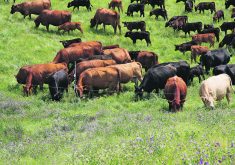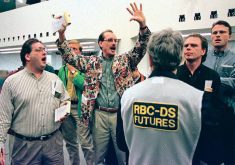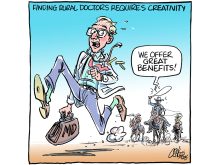Producers must manage seed future
By now, most grain producers are aware of the major thrust by Seed Synergy and their captured ally, Agriculture and Agri-Food Canada, to try and bring about a seed tax that was so eloquently labelled as “value creation.”
It was a cleverly lubricated PR campaign to have the grain producers fund the corporate seed industry and the rule makers that are so intimately integrated with them.
We can thankfully be relieved, at least temporarily, that nearly all of the grain commissions from across the Prairies came to that realization and made a joint statement that most producers were not in favour of the two options presented (end point royalties and trailing royalties), and essentially the process was hijacked out of the hands of the producers who clearly would have to pay for it.
Read Also

Kochia has become a significant problem for Prairie farmers
As you travel through southern Saskatchewan and Alberta, particularly in areas challenged by dry growing conditions, the magnitude of the kochia problem is easy to see.
When the powers of Big Seed (not unlike the lobbying abilities of Big Pharma and Big Oil) have nothing invested except to feed off of the peasants who were given limited choices by AAFC, it can only be equated to the feudal systems of ancient times. The term “royalty” fits the scenario offered, so accurately.
Grain producers need to ensure that we are masters of our own destiny. We cannot give our power away so easily to those who think they are the elite and distant planners. We need to be the pilots and not the just the economy passengers of creating and managing our seed industry in collaboration with the great plant breeders that have brought us to where we are today.
The corporatocracy dare not just steal what has been so successfully created to date, and AAFC should not be selling us off.
Kevin Niemi
Trochu, Alta.
Rail system not favourable to farmers
Re: “Shelving rail costing review puts gov’t on wrong track,” (WP editorial, Feb. 14).
I am writing in response to your editorial regarding the minister of transport’s refusal to fulfil the election promise of a full costing review of grain transportation by rail.
It is no secret that Transport Canada is always hesitant to pass any regulation or do anything that would affect the railroads without first having railroad approval. This is a result of the lobby power of the railroads.
I was pleased that you referred to the maximum revenue entitlement and not the revenue cap, a term that is often used. It is an entitlement to profit.
If grain is subject to among the lowest freight rates of commodities, and makes up such a large volume of traffic, one can only imagine the profit margin involved with other commodities. The MRE was proposed by the railroads when they refused to discuss “joint running rights” as proposed by Justice Willard Estey in his report in the late 1990s. The MRE was their suggestion, along with the comment that “we will never exceed it.”
You are correct in your statements regarding the cost base used to determine the MRE. The costing reviews that were held in 1992 and previous provided a formula for sharing of efficiencies gained throughout the system and ensuring that costs were kept current for the railroads. The railroads didn’t want to share the efficiencies, even though some of the gains were not a result of railroad operations. Thus, no further reviews after 1992. The MRE wasn’t implemented until 2000, at which time a costing review was overdue.
I would like to state a demonstration of railroad power, and how they work politically. In the late 1990s there was a group formed called the Farmer Rail Car Coalition (FRCC). The group was formed after a recommendation was made to the federal government to give the government-owned rail cars to the railroads. Farmers wanted some skin in the game, and the railroads didn’t like it.
In 1999 or early 2000, the Manitoba government was considering providing some funding to this group as the Saskatchewan government had done. Then president of CN Rail met with then Premier Gary Doer to try and discourage the funding. It worked, after his question of the premier, “do you like having the overhaul shop in Transcona?”
One other point on the FRCC. The group had developed a business plan and had obtained the required funding to purchase the cars. The repayment of principal, in part, would be paid out of the savings in rail car maintenance. This was one item in the costing formula. One year of this overcharge of $60 million was realized in crop year 2007-08. That was for one year. The railroads had also realized excess for other years.
Don Dewar,
Dauphin, Man.
Train braking systemneeds to be re-thought
Recently there have been three train wrecks that resulted in spectacular smash-ups of rail cars. The first, near Saskatoon, thankfully did not result in loss of life, even though two locomotives and 30 cars derailed at a level crossing.
In the Kicking Horse Pass, sadly three train crew lost their lives. My sincere sympathy is extended to their families.
In these incidents, there is now great puzzlement over the cause of these wrecks. Since the Lac Magantic disaster 5 1/2 years ago, nothing has changed with respect to rail safety. There is no mystery: simply put, trains have no brakes.
The air-brake system they use is virtually unchanged since it was invented by George Westinghouse in 1868.
As designed, they were capable of controlling the small trains of the day powered by steam engines hauling a few cars. The present system is woefully inadequate.
Here are the facts: train brakes are operated by the single air line system that is about 1.5 inches in diameter that runs the length of the train, often more than a mile. The area of the brake shoes on a standard 100 tonne grain car is about one sixth that of a standard 18-wheel semi that carries 30 tonnes. The weight of a loaded grain car is at least three times that of a semi. That means a semi has about 20 times the braking power as compared to a train.
Train brakes are barely capable of holding a car when it is stopped, let alone do anything to stop it when in motion. Trucks also have — and this is just as important as the brake capacity — spring powered brakes that are automatically applied in the event of air loss for any reason. This means that trucks must have a safe level of air pressure to release the brakes and allow the truck to move. This system of brake control is long overdue for trains. It has been mandatory for trucks for about 50 years and needs to be adopted by railways right away.
This system would stop runaways caused by not applying hand brakes. With spring brakes, the engineer can instantly apply parking brakes from the cab. In the event of derailment and resulting air loss, the spring brakes would slow the oncoming cars and prevent or reduce the spectacular pileups.
As it is now, the only thing that eventually stops the train is the size of the pile of wreckage.
Critics will question if what I say here is true, how do trains operate as safely as they do? Trains have the right of way — all others must get out of the way or suffer the consequences. Train tracks are constructed to be as level as possible with two percent grade max, unlike highways where hills are rarely considered in their design.
The main braking takes place through the locomotives. Since they are diesel-electric, massive braking is preformed by reversing the drive motors. This only fails when the weight of the train overcomes the traction of the locomotive.
Trains are among the largest and heaviest machines that humans construct. For context, a 112-car grain train, loaded, weighs 15,000 tonnes. The engines have a weight of 600 tonnes. That is a ratio of 25 to one. Clearly the locomotives cannot control the train safely without adequate brakes.
An alarming aspect to the rail scenario is the prospect of an additional 7,000 oil tank cars. Can you imagine the mess 112 oil cars dumped in the Kicking Horse River would make?
Unless swift, concrete action is taken to ensure railways modernize their brake systems, expect to see more wrecks — not if, but when.
I am calling on Marc Garneau, minister of transport, to convene a panel of rail engineering experts to find ways to address this problem.
Donald Voss
Spiritwood, Sask.
















